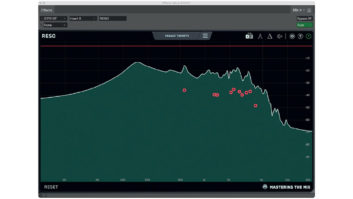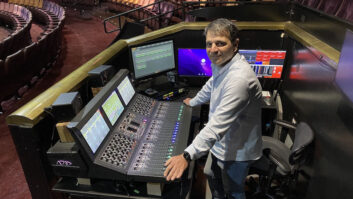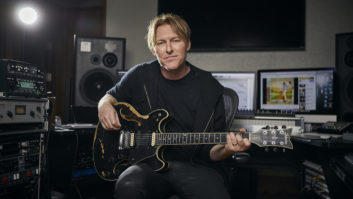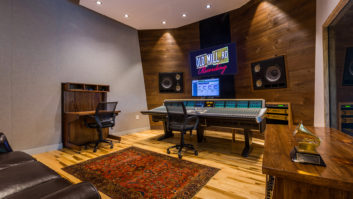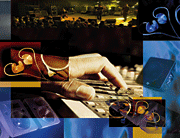
Illustration: Kay Marshall
Mixing monitors is like directing traffic in midtown Manhattan: Everyone wants to go first, no one is heading in the same direction, and nobody wants to listen to the same music. Mixing monitors has never been an easy gig, and it becomes more complicated when wedges are combined with personal monitors. Successfully combining these two approaches requires an engineer with good ears and a solid technical background. To bring you helpful insights for such situations, Mix spoke with three monitor engineers and a manufacturer of in-ear monitors, all of whom have effectively merged the technologies.
Most engineers agree that wedges and personal monitors share the same stage because some musicians are opposed to (or are not confident with) using earpieces, while other players prefer to use personal monitors, although they miss the visceral impact offered by traditional wedges or sidefills.
Marty Garcia is the president of Future Sonics and a pioneer in the use of personal monitors. Garcia observes that many performers “lack knowledge or confidence that such a tiny device can deliver the big sound and feel of an open stage. They have a mindset of getting intelligibility, timing and pitch through the earpieces while getting the energy and feel from the wedges. The number of wedges will determine how well the personal monitors will perform because the personal monitor system competes with them. I suggest starting without the wedges and creating a mix during soundcheck with proper gain structure for the earpieces, as if you were in a studio recording situation. If the first thing a performer hears is a clipped kick drum, then they are put off to the whole idea immediately. If you can create a polished mix before your performers come in, they’ll have a positive reaction. Once you accomplish that, the need to add a lot of audio in the wedges decreases quite a bit.”
When combining personal monitors with wedges, Garcia recommends adding low-frequency audio to the wedges. “A very successful technique is to add low-frequency information to fill out the bass, kick, [sometimes] snare and lower range of the vocal,” he says. “That can give the performer the energy and feel they desire. If the earpiece has a wide dynamic range, especially in the low frequencies, and a tight fit, then the performer will actually get a lot of energy from the ear mix. That’s why we use a dynamic driver in our Future Sonics Ear Monitors® brand — it helps deliver the energy the musician wants without the need to crank up the level, which, of course, can result in fatigue. If the dynamic range of the earpiece is limited, then there’s a tendency for the performer to want more energy out of the wedges, starting that competitive thing again.”
IN-EARS FOR YOU, TOO
Niall Slevin is one of three monitor engineers working with U2. Slevin’s responsibility is mixing monitors for The Edge, while Robbie Adams handles Bono’s mixes and David Skaff takes care of Larry Mullen Jr. and Adam Clayton. Slevin runs a stereo ear mix for The Edge in addition to a pair of wedges. “One reason we have wedges up there,” Slevin explains, “is for backup. We haven’t had any problems, but in case there’s an RF issue, I have a band mix ready to go for the stage monitors.
“Usually, The Edge just gets a bit of kick and snare from the wedges. We have a pair of subs underneath the stage to give him subharmonic information he can feel. A lot of people who have just started using in-ears miss the banter between themselves, the band and the rest of the crew. They feel slightly isolated, so you’ll see them take one ear out and use a wedge or two. It gives them the ability to key off one earpiece [the vocal] without feeling so isolated. The problem is that the level you supply to the ears goes up and you can fatigue the ears because the earpiece is battling against the SPL of the wedge.”

Neil Heal: “…the earpieces supply the detail, and the wedges and sidefills provide the feel and more of the low-frequency content.”
Photo: Steve Jennings
However, this is not the case with The Edge, according to Slevin. “I use a separate aux send on the monitor console to feed a bit of bass guitar and kick into the subs. I can reduce the level of bass guitar in his in-ears and he’ll feel the rest of the information from the subs. They fill out his ear mix. It took quite a bit of EQ’ing to make it sound natural because the subs are underneath the deck, but once we got there, it helped bring down the overall level of kick and bass guitar in his ear mix.
“I also found that I could lower the snare drum quite a bit simply by panning the top snare mic away from the bottom snare mic,” Slevin continues. “It gave the snare quite a bit more definition, and bringing these levels down helps reduce fatigue over a two-hour show.”
The Edge wears two earpieces, so to deal with any “over-isolation” issues, Slevin places six ambient mics across the front of the stage and points a couple of those back toward the band to get a bit of guitar and drums. “Bleeding that into his mix provides a more normal stage sound,” notes Slevin. “I might move them around a bit during soundcheck depending on how dry or live the room is, but usually they aim toward the guitars and are not very loud in the in-ears. I EQ them for a bit of presence and [add] a lot of highpass as a kind of ‘pastel shade’ on the backdrop. There’s no use putting anything into an earpiece that you don’t need. He couldn’t play with just those mics, but they certainly smooth the guitars a bit. Since he changes guitar sounds on quite a few songs, it makes the transitions more natural.”

Niall Slevin (center, with U2 engineers Joe O’Herlihy, left, and Jo Ravitch): “A lot of people who have just started using in-ears miss the banter between themselves, the band and the rest of the crew. They feel slightly isolated, so you’ll see them take one ear out and use a wedge or two.”
Sean Quackenbush has been working with Robert Randolph & The Family Band for approximately four years and is now assisted by Brian Lang on monitors. At one point, Quackenbush had 18 wedge mixes that he would set at soundcheck and then run out to front of house to mix the show. “[Bandmembers] started wearing one earpiece but weren’t willing to give up wedges, so it was always a fight,” Quackenbush explains. “You’d turn the ear up and then the wedge all night. One got louder than the other until they were as loud as could be and drowned each other out. We learned to not put too much of anything into one monitor.”
Randolph uses two wedge mixes and one ear mix. The wedges sit next to each other on Randolph’s right and he uses a Sensaphonics earpiece in his left ear. One wedge provides lead and backing vocals, while the other provides a band mix. “We get a lot of clarity because we’re not trying to cram everything through a 12-inch speaker and a 2-inch diaphragm,” says Quackenbush. “We use the ear mix for his vocal, maybe a bit of backing vocals and his own guitar. I give him some reverb — a short plate — on his voice for a bit of space. We’ve been able to reduce the stage volume due to the clarity we get from this combination of mixes, especially when we have good microphones.
“On Robert’s guitar,” Quackenbush continues, “we use a Sennheiser e609 and a Neumann TLM103. We tend to put the e609 in the wedges [and then apply a highpass filter] around 120 Hz — there’s not much happening below that — then EQ them separately to get the nice high end and warm lows from the TLM103, plus the warm mid from the e609. We’ll use the e609 in the wedges and either the condenser or a combination in the ears to get the full guitar sound Robert hears when he listens to his amplifier.”
Randolph’s vocal mic is split to two channels, providing separate EQ for the wedges and the earpiece. “We can use a higher highpass frequency and also EQ the top end down a bit in the wedge to get it at a level Robert likes,” Quackenbush explains. “We use a separate reverb send and run the highpass a bit lower for the ear mix without affecting the wedge. It also allows us to do other things, like putting a tube compressor on the vocal and really squashing it down in the ears to keep it level, even to a whisper. If you try that with a wedge, you’re asking for trouble.

Sean Quackenbush: “We’ve been able to reduce the stage volume due to the clarity we get from this combination of mixes, especially when we have good microphones.”
“We have played around with ambient mics, but they have an extremely loud stage volume and get a lot of bleed back through the vocal mics,” he continues. “Since the vocal mics are loud in their mixes, they get plenty of ambience. Sometimes, I’ll put up a pair of Sennheiser condenser mics that go to the monitor desk for recording, but Randolph hasn’t yet had the chance to play with an open canal that lets ambient information into the earpiece. Now he is producing earpieces with tiny microphones that pick up ambient sound. Those mics can be added into the ear mix, and each bandmember can control the amount of ambient sound they hear. The nice part is that when you turn your head, the image follows your ear, so it’s almost like not having your ears sealed. If you use audience mics — no matter where you walk or in what direction you turn — you always hear the audience the same. These mics turn with you when you move your head. It’s a very interesting concept.”
Neil Heal mixes monitors for The Raconteurs using a variety of wedge mixes and ear mixes. “For [bassist] Jack Lawrence, the ears [Ultimate Ears UE-7 Pro] are mainly to protect his hearing,” says Heal. “The onstage SPL is between 125 and 130 dB. With earpieces, he can hear what he needs without resorting to excessive wedge volumes. The mix for the ears is similar to his wedge mix, and any additions are usually cymbals and audience mics. In this configuration, the earpieces supply the detail, and the wedges and sidefills provide the feel and more of the low-frequency content. The sidefills also help in terms of adding pan-type effects. For example, if you have two guitar amps with a tremolo pedal that pans between the amps, you can send one amp to the wedge mix and the other amp to the nearest sidefill. This adds a nice sense of stereo to the player’s mix, and sometimes you can enhance this by reversing the phase of one signal.
“My approach to mixing monitors really hasn’t changed much although I do have to consider RF with ears,” Heal continues. “My stage is always as clean and free as possible from any buzzes or hums, and I make sure my ears are, too.”
Ultimately, Heal feels his job is to remain fairly invisible so the artist doesn’t even think about him being there. “I am there to provide them with what they need to hear to play a great show. They know I am watching intently for cues if needed, but I know when a particular part should be louder in a certain mix. I very rarely get asked for anything during a performance. It’s all about having a good relationship with the artist, understanding their likes and dislikes, and providing accordingly.”
Steve La Cerra is Mix’s sound reinforcement editor.

